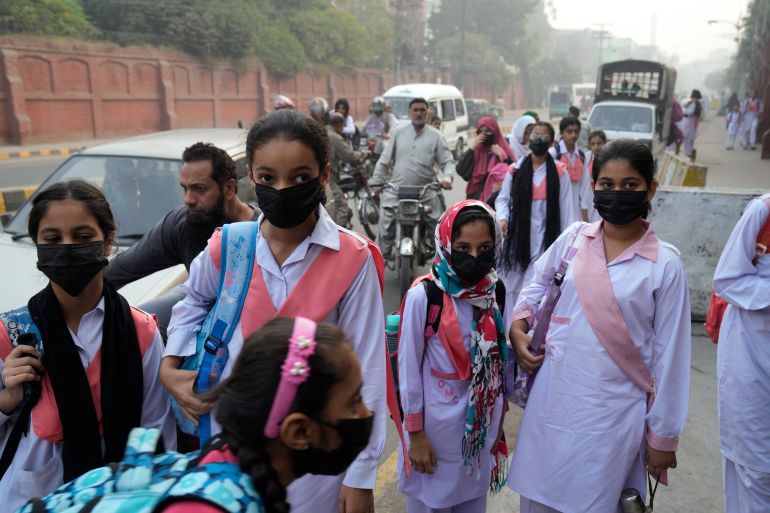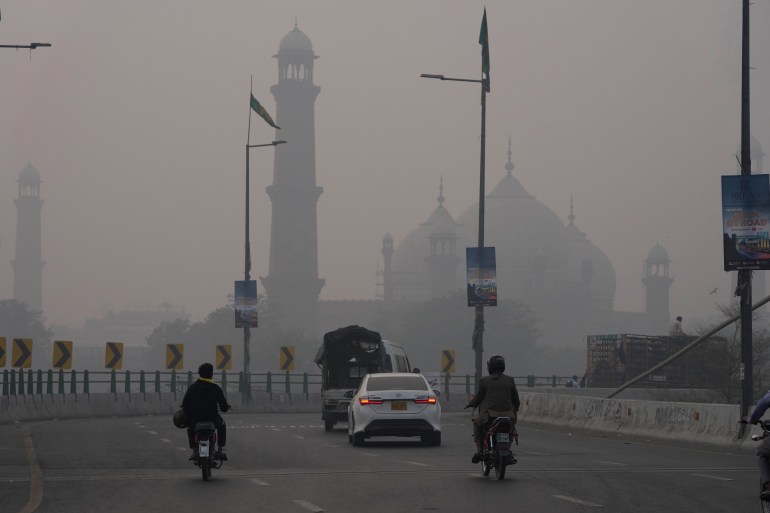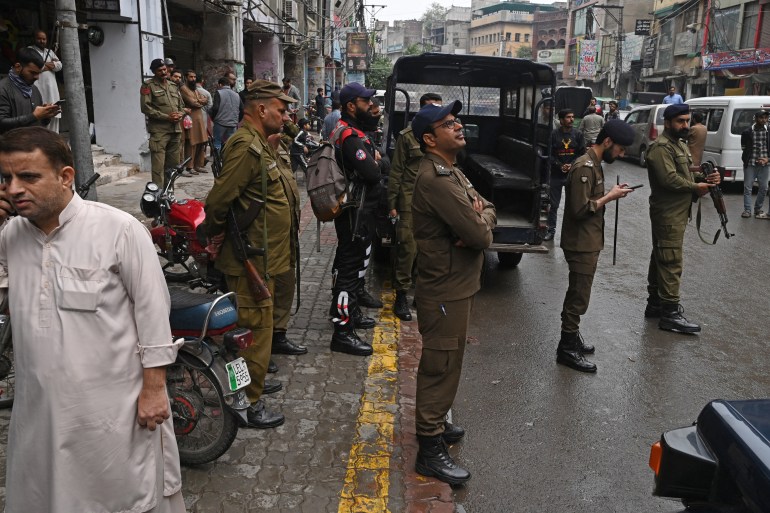In Lahore, it’s that toxic, smoggy time of year again
Smog season in Pakistan triggers the annual round of allergies, breathing difficulties and even government lockdowns

Lahore, Pakistan – For Eman Khosa, a 14-year-old schoolgirl who lives in Pakistan’s second largest city, the start of the last two months of the year marks the onset of familiar irritants – toxic air, allergies, a sore throat and a great reluctance to step outdoors.
“Every year, the beginning of winter is the same,” Eman, who is in ninth grade, told Al Jazeera. “Every year around this time, smog comes. The government takes some measures, and when the smog season ends, we go back to normal.”
Her mother, Suraya Saleem Khosa, a visual artist, said that while weather conditions last year meant that the smog was not quite as bad as usual, this year, it is “far more intense”.
“AQI [Air Quality Index] readings are once again sky-high. There is no respite, no wind. Lots of ill-thought government road projects which are only adding to the pollution,” Khosa said.
Air quality rated ‘hazardous’
Lahore, the capital of the eastern province of Punjab, which borders India, is home to nearly 15 million people. This year, it is back in the headlines due to its toxic air.
Hundreds of people have reported illnesses from allergies to respiratory issues triggered by the worsening air quality in the city.
Lahore ranked as the city with the world’s worst air quality for three consecutive days this week, according to AirVisual, an international air quality monitoring service.
The index, which measures air pollution, uses calculations from the United States Environmental Protection Agency.
The city scored 406, 372 and 422 on its AQI from Tuesday through Thursday, and only after a spell of rain on Friday did the AQI drop down to 108. Later on Friday, it sat at 152.
This compares with Friday’s reading of 25 for London, 61 for Istanbul and 88 for Mexico City.

According to AirVisual, the concentration of tiny particulate matter in the air of Lahore approached 450 this week, which is 30 times higher than the World Health Organisation’s recommended maximum average daily exposure and is considered hazardous.
AQI exceeding 100 is considered “unhealthy” while higher than 300 is considered “hazardous”. Pakistan’s own classification system is more lenient – considering an AQI over 200 as “unhealthy” and a reading beyond 400 “hazardous”.
‘Stubble burning’ to blame
Regardless of whether the air was “hazardous” or merely “unhealthy”, the Punjab government declared a public holiday on Friday, allowing a four-day holiday in the province, which included the existing Thursday off.
Public spaces, restaurants and markets were all shut down, and the government announced a “lockdown” to improve the environmental situation, requiring people to remain indoors.
The interim health minister for Punjab, Dr Javed Akram, said the extra holiday was a one-off to reduce the traffic in the city, which could help to reduce the pollution.
But he blamed farmers in Pakistan and India who are burning crop stubble after harvesting rice to clear out space for wheat crops. “The stubble burning remains a key challenge, most of which takes place in India, and we cannot do much about that,” he told Al Jazeera.
Mohammad Farooq Alam, deputy director of the Punjab government’s Environmental Protection Agency, added: “Crop stubble burning in India is at least five times more than what Pakistani farmers burn. When wind direction is on our side, there is little that we can do to control that.”
He said the provincial government had taken steps where it could, such as imposing fines on local farmers and examining other means of getting rid of agricultural waste.
However, he also acknowledged: “Vehicular pollution is a major reason behind the degradation of our environment.”
Atmospheric conditions from October and late November in the region have also caused pollutants to be trapped closer to the ground, worsening the smog intensity, Alam added.

Sara Hayat, a lawyer specialising in climate change law, policy and advocacy in Pakistan, said that while she agreed with the government decision to announce a lockdown right now, “institutional policies” make it impossible to enforce.
“The government wants to clamp down but is never successful because they do not spread the requisite awareness beforehand. This is merely a temporary measure, without warning, and it won’t be useful without long-term policies in place,” the Lahore-based lawyer told Al Jazeera.
‘Mentally draining’
For citizens of Lahore, the shutdown only means further disruption to their daily routines on top of the toxic air they have no choice but to breathe in.
Moazzam Maqsood, a business owner based in Gawalmandi, one of the more densely populated areas of Lahore, said the government’s decision to close the markets had caused his printing business losses in the “hundreds of thousands” of rupees (100,000 rupees is equivalent to $353).
“We cannot go to market, we cannot have our staff come to the office either, which causes us loss of business. But then sitting at home breathing this foul air is not helping my health either,” he said.
Back at home with her 14-year-old daughter, Khosa said she is lucky enough to own an air purifier – a machine that lessens the physical, but not the mental, impact of the smog season.
“We stock up on face masks, keep checking if all the windows are shut, but mentally, it is draining,” she told Al Jazeera. “It is dreary and depressing and pulls us all down. We don’t look forward to spending autumn in Lahore any more.”
Eman said that after living through the COVID-19 pandemic for two years, during which she did online schooling, it is very important to her to go physically to school. Smog season means her daily routine is disturbed.
“We have exams coming up, and we need to go to school for preparation, but with school closed, we cannot. I love to play tennis in the evening, but I cannot do that either as that is when the smog is at its worst.
“Some of my classmates have allergies and have developed asthma. We barely have any opportunity to go out now.”